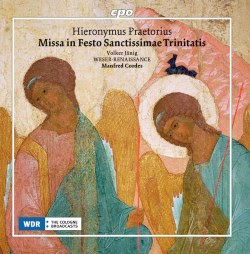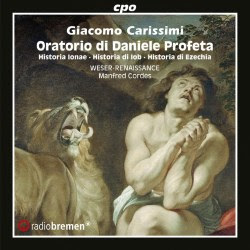Program: #19-14 Air Date: Mar 25, 2019
To listen to this show, you must first LOG IN. If you have already logged in, but you are still seeing this message, please SUBSCRIBE or UPGRADE your subscriber level today.
The great German label gives us a mass by Hieronymus Praetorius, oratorios by Carissimi, and sacred concertos on Psalm 31 by Johann Rosenmuller.
NOTE: All of the releases on this program are on the German label CPO.
I. Hieronymus Praetorius: Missa in Festo Sanctissimae Trinitatis (Weser-Renaissance/Manfred Cordes). CPO CD 777 954-2.

He had a composer son Jacob who died 1651. Neither is related to the more famous Michael Praetorius who has become known for his oft-recorded ‘Terpsichorean Dances’ but also wrote motets and the famous treatise ‘Syntagma Musicum’. He came from Thuringia in what was East Germany.
Hieronymus often composed for double choir at the same time, it seems as Andrea Gabrieli (d.1585) and Giovanni, yet he is not known to have travelled to Italy. His usual technique is to “alternate and echo smaller groups of three of four voices of higher and lower ranges” ….creating…. “a varied repetition of phrases” which in turn aids “balance, emphasis, or an increase in intensity” (booklet essay by Frederick Gable).
Hieronymus’s music was extensively published in his lifetime as his considerable fame grew, that is in 1616 with six mass settings and others in 1599 and 1602 which were largely motets. In 1611 a so-called complete edition came out which included his organ works. Latin was still acceptable in the German church although in a revised form and was still studied in the schools.
This Missa In Festo Sanctissimae Trinitatis set for the Trinity Sunday, which falls a week after Pentecost, is put into a liturgical context meaning that parts of the service like the Epistle and Gospel are chanted. However other gaps in the service are filled with motets.
Because the composer did not write a three-fold Agnus Dei the middle one is filled out with an organ setting, this also happens more extensively in the Kyrie where a nine-fold declamation (split into three tracks) is shared by the polyphonic setting for the choir, some plainchant and an organ solo. The Creed (Wir gläuben all an einem Gott) is a hymn-like setting which paraphrases the traditional text. The closing Te Deum Patrem likewise. Some passages of the Pater Noster are often chanted on one pitch and this could have made it suitable for congregational use.
The organ used dictated the recording project in the Marienkirche in Lemgo. This church is Gothic in origin and as it happens I have visited it only recently and seen the instrument at close hand. It is of a type, as Harald Vogel reminds us in his brief essay, known as a ‘Swallows–nest organ” , that is, it lies not in a west gallery but in its own freestanding space fixed between the vaulting and the pillars. It dates from the period of Praetorius’s lifetime and is an obvious rarity the organ therefore is one of the instruments also used within the instrumental ensemble. As Gable says, we do not know with certainty which instruments might have been used by Praetorius but the city authorities (in Hamburg) employed cornetti and string players so it can be assumed that they were used especially on special feast days.
Cortes adds to his excellent six-voiced vocal ensemble seven other instruments including a ‘zink’, that is simple cornetto and two posaune (trombones). The sound is impressive and spacious but there are times when the quite small vocal ensemble is too recessed against the instruments. Not only is the balance spoiled but the diction is lost all too often. I should imagine therefore that the church acoustic was a challenge but also a joy to work with.
- Adesto unus Deus, motet for 5 voices (Cantiones sacrae 1599, No. 34) (03:46)
-
Work(s): Kyrie eleison: a) Orgel solo: Kyrie “Magne Deus” /
-
Work(s): Christe eleison: a) choraliter / b) Orgel solo: s.
-
Work(s): Kyrie eleison: a) choraliter / b) Orgel solo: s.o.
-
Missa Benedicam Dominum, for 6 voices: Gloria in excelsis Deo
- Gloria in excelsis Deo (05:38)
-
Work(s): Salutatio, Kollekte, Epistel, Halleluja (Greeting,
- Domine, Dominus noster, motet for 8 voices (08:32)
-
Work(s): O lux beata Trinitas: a) a) choraliter / b) Orgel
- Wir gläuben all an einen Gott, à 4 (05:19)
- Benedicamus Domino (03:48)
- Praefatio (03:29)
-
Missa Benedicam Dominum, for 6 voices: Sanctus, Benedictus
- Sanctus, Benedictus (03:11)
- Pater Noster, motet by 8 voices (02:35)
- Words of Institution (01:31)
-
Missa Benedicam Dominum, for 6 voices: Agnus Dei
- Agnus Dei (05:03)
-
Work(s): Salutatio, Kollekte, Segen (Greeting, Collect, Ble
- Te Deum Patrem ingenitum, motet for 8 voices (04:15)
II. Giacomo Carissimi: Oratorio di Daniele Profeta (Weser-Renaissance/Manfred Cordes). CPO CD 777 489-2.

The group WESER-RENAISSANCE may be an unfamiliar name outside Germany, but a brief glance down their roster reveals some distinguished members, most notably Hille Perl, who currently could be regarded as the doyenne of gambists, while the chitarrone player Lee Santana is similarly renowned (and happens to be Perl’s husband). Both featured on the tenor John Potter’s recent ECM release Secret History which I reviewed a couple of months back. The vocal personnel are less well-known to me; however they all sound superb, secure in their beautifully executed solo contributions while one of the joys of this excellent disc is the recorded balance which consistently reveals how well-matched they are in ensemble. It is something of a puzzle why this CPO disc, recorded back in 2009, has only now seen the light of day.
Only two of Carissimi’s ‘Italian’ (as opposed to Latin) oratorios have survived the last four centuries; one of these is the Oratorio di Daniele Profeta (The Oratorio of Daniel the Prophet). Veronika Greuel has contributed an extensive scholarly essay to this issue explaining how oratorio form came into being, and traces its roots right back to the perceived decline in the morality of the Catholic Church at the outset of the 16th century. This effectively led to Luther’s 95 Theses, and via the Council of Trent and the subsequent work of the Florentine priest Filippo Neri, the pontifical group known as the ‘Oratorians’ emerged. The oratorio form was thus anything but an overnight sensation, its eventual development rather tortuous. Carissimi was evidently one of its pioneers, and while the passage of time makes it difficult to date precisely any of his works, 1656 seems likely for Daniele as it was written for a private function involving Queen Christina of Sweden who had recently converted to Catholicism and is known to have been in Rome, where Carissimi was domiciled, at the time. It is relatively austere, mostly involving single voices involved in narrative or dialogue. These individuals are mostly accompanied by single instruments, Santana’s chittarone in the case of the narrator, organ in the case of Darius while Daniel’s part is occasionally shaded with the russet tones of Perl’s gamba in tandem with the chitarrone. I suppose this (and the Italian language which Carissimi uses most expressively here) perfectly illustrates the form’s operatic roots; while the relative severity of much of the music reflects this period where liturgy and dramaturgy tentatively overlap. All the individual voices sound wonderful and effortlessly convey the personalities and weaknesses of the main protagonists. Hans Jörg Mammel (tenor) is a humane narrator, while his diction and intonation project both lucidity and character. The rich colours of the chittarone are faithfully captured by the CPO engineers in the first part of the work- it is pretty omnipresent but never allowed to divert attention from the singers. As the work proceeds, the voices are heard together with increased frequency and the small instrumental ensemble opens out into something a little more effusive. This Daniele ends badly for the eponymous prophet – with his death at the hands of the lion. Carissimi excludes the benign intervention of the angel.
The two sopranos Monika Mauch and Andrea Brown duet beautifully throughout the following Historia di Ezechia, their voices delightfully matched. Another star in this performance is the superb bass Harry van der Kamp whose brief contributions reveal a wonderfully ripe, characterful voice. For this listener at least the greater compression and concentration of the shorter works provide a more satisfying and varied musical experience than the oratorio. Cordes marshalls his supremely gifted instrumental and vocal forces with taste and confidence throughout , making the most of the distinctiveness of each individual voice and thus maximising the dramatic contrasts inherent in each work. Moreover the combinations of instrumental textures and shades available to him consistently tease and delight the ear.
Histioria Ionae (Jonah) and Historia di Job (Job) open the disc and both are tastefully rendered here. Jonah in particular is a highlight, benefitting as it does from the full complement of eight voices and six instrumentalists, while at the other extreme Job illustrates one brief episode involving Satan (another tour-de-force from van der Kamp) Job (the high tenor of Mirko Ludwig) and the Angel (Monika Mauch); these characters are again matched with specific instrumental voices to heighten the contrasts of the characters; thus the angel is paired with the ethereal Positive Organ; Job with the plucked sounds of harp and chitarrone, while the growling harpsichord amplifies the goading Satan. Historia di Job is clearly a mini-masterpiece, one of Carissimi’s finest inspirations and deserves to be better-known. In this regard I suspect its ‘awkward’ length may have gravitated against it over time.
Historia di Iob [9:47]
Oratorio di Daniele Profeta (1656) [31:39]
Historia di Ezechia [13:19]
III. Johann Rosenmüller: In te Domine speravi (Weser-Renaissance/Manfred Cordes). CPO CD 555 165-2.

- In te Domine speravi, sacred concerto after Psalm 31 for 5 soloists, double chorus, 5 instruments & continuo
- In te Domine speravi, sacred concerto after Psalm 31 for alto, tenor, 2 violins & continuo
- In te Domine speravi, sacred concerto after Psalm 31 for soprano, 2 violins & continuo
- In te Domine speravi, sacred concerto after Psalm 31 for tenor, 2 violins & continuo
- In te Domine speravi, sacred concerto after Psalm 31 for soprano, alto, 2 violins & continuo
- In te Domine speravi, sacred concerto after Psalm 31 for 2 sopranos, 2 tenors, 2 violins & continuo
- In te Domine speravi, sacred concerto after Psalm 31 for alto, 2 violins, 2 violas da gamba, bassoon & continuo
Composer Info
Hieronymus Praetorius, Giacomo Carissimi, Johann Rosenmüller
CD Info
CPO CD 777 954-2, CPO CD 777 489-2, CPO CD 555 165-2